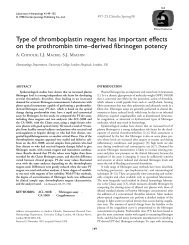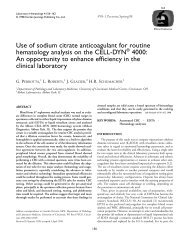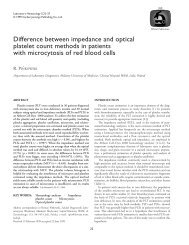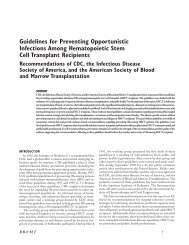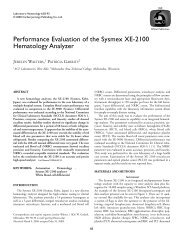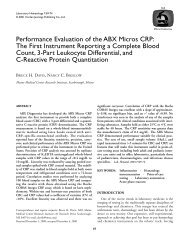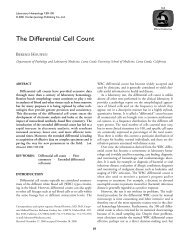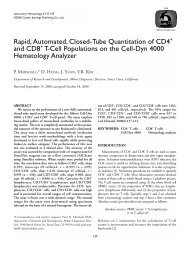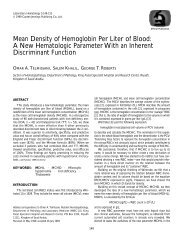Evaluation of the Beckman-Coulter GEN-S hematology analyzer
Evaluation of the Beckman-Coulter GEN-S hematology analyzer
Evaluation of the Beckman-Coulter GEN-S hematology analyzer
Create successful ePaper yourself
Turn your PDF publications into a flip-book with our unique Google optimized e-Paper software.
ISLH<br />
Laboratory Hematology 4:264–268<br />
© 1998 Carden Jennings Publishing Co., Ltd.<br />
Official Publication<br />
<strong>Evaluation</strong> <strong>of</strong> <strong>the</strong> <strong>Beckman</strong>-<strong>Coulter</strong> ® <strong>GEN</strong>-S <br />
<strong>hematology</strong> <strong>analyzer</strong><br />
E. GRIMALDI, F. SCOPACASA<br />
Department <strong>of</strong> Laboratory Medicine, University Federico II, Naples, Italy<br />
ABSTRACT<br />
The <strong>Beckman</strong>-<strong>Coulter</strong> <strong>GEN</strong>-S, a new generation <strong>hematology</strong><br />
<strong>analyzer</strong> capable <strong>of</strong> providing a complete blood count, a five-part<br />
differential leukocyte count, and a reticulocyte count, was evaluated<br />
on <strong>the</strong> basis <strong>of</strong> <strong>the</strong> H20-A protocol <strong>of</strong> <strong>the</strong> National Committee<br />
for Clinical Laboratory Standards and its performance compared<br />
with <strong>the</strong> Bayer-Technicon H-2 <strong>analyzer</strong> that is routinely<br />
used in our laboratory. A lipid interference experiment was also<br />
performed. Linearity, carryover, and precision were all within <strong>the</strong><br />
limits established by <strong>the</strong> manufacturer, and satisfactory agreement<br />
with <strong>the</strong> H-2 <strong>analyzer</strong> was found. The evaluation <strong>of</strong> <strong>the</strong> leukocyte<br />
differential indicates an excellent correlation between <strong>the</strong> manual<br />
reference method for neutrophils and lymphocytes<br />
(r = 0.981 and 0.971, respectively), a good correlation for monocytes<br />
and eosinophils (r = 0.820 and 0.883, respectively), and a<br />
poor correlation for basophils in samples with low counts—for<br />
basophil counts higher than 1% we found an improvement in <strong>the</strong><br />
correlation. The leukocyte differential flag sensitivity assessment<br />
shows higher specificity (96%) than sensitivity (85%) and a high<br />
efficiency (93%). In <strong>the</strong> lipid interference experiment, only<br />
hemoglobin determination has been significantly influenced on<br />
<strong>the</strong> <strong>GEN</strong>-S. Lab Hematol 4:264–268, 1998<br />
KEY WORDS: Blood cell counter · Accuracy ·<br />
Precision · Interference<br />
INTRODUCTION<br />
The <strong>GEN</strong>-S (<strong>Beckman</strong>-<strong>Coulter</strong>, Miami, FL) is a new generation<br />
fully automated <strong>hematology</strong> <strong>analyzer</strong> that can provide <strong>the</strong> laboratory<br />
with up to 34 blood count parameters: a complete blood<br />
count (CBC), a five-part differential leukocyte count (DLC), a<br />
complete reticulocyte count, and an automated CD4/CD8 count.<br />
Moreover, when abnormal leukocytes are present, <strong>the</strong> system generates<br />
different flags.<br />
Address correspondence to Ernesto Grimaldi, MD, Dipartimento Assistenziale<br />
di Medicina di Laboratorio, Policlinico Universitario Federico II, Via S. Pansini<br />
5, 80131 Napoli, Italia.<br />
Received 4 September 1998; accepted 3 November 1998<br />
Over a 3-month period we evaluated, on <strong>the</strong> basis <strong>of</strong> <strong>the</strong> H20-A<br />
protocol <strong>of</strong> <strong>the</strong> National Committee for Clinical and Laboratory<br />
Standards (NCCLS) [1], <strong>the</strong> CBC and DLC performance <strong>of</strong> <strong>the</strong><br />
<strong>GEN</strong>-S in comparison with a reference fully automated <strong>hematology</strong><br />
<strong>analyzer</strong> in use in our laboratory, <strong>the</strong> Bayer-Technicon H-2 (Bayer-<br />
Technicon Instruments, Tarrytown, NY), and with <strong>the</strong> reference<br />
manual method (DLC performance only). We also evaluated <strong>the</strong><br />
clinical sensitivity and <strong>the</strong> lipid interference on both instruments.<br />
MATERIALS AND METHODS<br />
System Description<br />
The <strong>GEN</strong>-S <strong>analyzer</strong> uses <strong>the</strong> <strong>Coulter</strong> Volume, Conductivity,<br />
Scatter (VCS) technology to probe hydrodynamically focused cells<br />
[2]. Volume measurement is performed using <strong>the</strong> <strong>Coulter</strong> principle<br />
<strong>of</strong> electrical impedance.<br />
The high frequency conductivity provides information about<br />
cell size, internal structure, and density. A helium-neon laser and a<br />
multiple-angle light scatter provide information about a cell’s internal<br />
structure, granularity, and surface morphology. VCS technology<br />
has proven effective on <strong>the</strong> <strong>Coulter</strong> STKS and MAXM <strong>analyzer</strong>s<br />
[3,4]. The <strong>GEN</strong>-S refines this technology through <strong>the</strong> use <strong>of</strong> <strong>the</strong><br />
IntelliKinetic (<strong>Beckman</strong>-<strong>Coulter</strong>) application. This hardware and<br />
s<strong>of</strong>tware system intelligently manages variations in <strong>the</strong> ambient laboratory<br />
temperature through automatic adjustments <strong>of</strong> reagent<br />
reaction temperature, exposure time, and delivery volumes.<br />
Enhancement in instrument electronics works with <strong>the</strong> IntelliKinetic<br />
application to provide better data signals for <strong>the</strong> system algorithm<br />
to analyze. Collected data are analyzed by <strong>Coulter</strong> AccuGate<br />
s<strong>of</strong>tware (version EASE 2, <strong>Beckman</strong>-<strong>Coulter</strong>), which contains<br />
adaptive statistical tools that assist in delineating overlapping populations<br />
including new suspect flags (e.g., Ly blast for Lymphoblast<br />
suspect) and additional “research use only” parameters. DLC data<br />
can be presented in a multidimensional format.<br />
Blood Samples<br />
The evaluation <strong>of</strong> <strong>the</strong> instrument was performed by analyzing<br />
blood specimens from routine samples obtained after having<br />
received each patient’s written informed consent. All samples were<br />
collected in evacuated 3.5-mL tubes containing tripotassium ethylenediaminetetraacetic<br />
acid (K 3 EDTA) and tested within 2 hours <strong>of</strong><br />
drawing <strong>the</strong> blood. All samples were analyzed in parallel on <strong>the</strong><br />
<strong>GEN</strong>-S and H-2 <strong>analyzer</strong>s.<br />
264
<strong>Beckman</strong>-<strong>Coulter</strong> <strong>GEN</strong>-S 265<br />
TABLE 1. Percent carryover with <strong>the</strong> <strong>Beckman</strong>-<strong>Coulter</strong> ® <strong>GEN</strong>-S <br />
<strong>analyzer</strong><br />
Parameter<br />
WBC RBC Hb PLT<br />
Carryover (%) 0.5 0.3 0.4 0.01<br />
Hb, hemoglobin; PLT, platelet; RBC, red blood cell count; WBC, white blood<br />
cell count.<br />
Carryover Assessment<br />
Carryover assessment was performed according to <strong>the</strong><br />
Broughton method [5]: a high sample was tested three consecutive<br />
times (H1, H2, H3) and followed by a low-sample testing performed<br />
three consecutive times (L1, L2, L3). The percentage <strong>of</strong><br />
carryover for each parameter was calculated using formula 1:<br />
[(L1 – L3)/(H3 – L3)] 100<br />
Linearity<br />
Linearity was evaluated by analyzing serial dilutions <strong>of</strong> five specimens<br />
in platelet-free autologous plasma [6]. Results were evaluated<br />
in accordance with <strong>the</strong> International Council for Standardization in<br />
Hematology (ICSH) recommendations [5].<br />
Imprecision<br />
For a between-batch imprecision study, 20 samples, in triplicate<br />
and in three consecutive batches, were analyzed; within-batch<br />
imprecision was evaluated by analyzing 20 samples in triplicate in<br />
<strong>the</strong> same batch. Results were expressed as mean, standard deviation<br />
(SD), and percent coefficient <strong>of</strong> variation (%CV).<br />
Comparability<br />
Selected on <strong>the</strong> basis <strong>of</strong> <strong>the</strong> recommended ICSH range <strong>of</strong> values<br />
[7], 120 blood samples were analyzed side by side using <strong>the</strong> <strong>GEN</strong>-S<br />
and <strong>the</strong> H-2 <strong>analyzer</strong>s. Instruments were calibrated according to<br />
<strong>the</strong> manufacturer’s guidelines. Measured white blood cell count<br />
TABLE 2. Linearity <strong>of</strong> <strong>the</strong> <strong>Beckman</strong>-<strong>Coulter</strong> ® <strong>GEN</strong>-S <strong>analyzer</strong><br />
Parameter SI unit Range r Intercept Slope<br />
WBC 10 9 /L 0.15–100 0.999 –0.002 0.998<br />
RBC 10 12 /L 0.17–7.0 0.999 –0.023 1.000<br />
HB g/dL 0.50–20.0 0.999 –0.066 1.000<br />
PLT 10 9 /L 6.20–1000 0.999 –2.200 1.002<br />
(WBC), red blood cell count (RBC), hemoglobin (Hb), mean cell<br />
volume (MCV), platelet (PLT), and DLC parameters (absolute values)<br />
were compared by linear regression analysis, and correlation<br />
coefficients (r) also were calculated.<br />
Also, 112 blood samples were compared with manual DLC<br />
(percent values). All films were examined independently by four<br />
experienced technologists, results compared by linear regression,<br />
and correlation coefficients calculated [1].<br />
Clinical Sensitivity<br />
As recommended in <strong>the</strong> NCCLS guidelines [1], <strong>the</strong> result <strong>of</strong><br />
microscopic examination was used to classify a sample as normal or<br />
abnormal; <strong>the</strong>refore, differential results <strong>of</strong> 112 samples were divided<br />
into <strong>the</strong> following categories:<br />
• true-negatives: normal samples leading no instrument flags<br />
• true-positives: abnormal samples leading instrument flags<br />
• false-positives: normal samples leading instrument flags<br />
• false-negatives: abnormal samples leading no instrument flags<br />
The results were analyzed following <strong>the</strong> method <strong>of</strong> Galen and<br />
Gambino [8].<br />
Interference Study<br />
Lipid interference was evaluated in 10 blood samples with<br />
increasing amounts <strong>of</strong> Intralipid (Pharmacia AB, Uppsala, Sweden)<br />
(soya’s lipids). They were analyzed side by side with <strong>the</strong> two instruments<br />
and each test was performed in triplicate. Results were<br />
expressed as <strong>the</strong> mean value <strong>of</strong> three determinations. The lipid concentration<br />
was measured as triglycerides.<br />
TABLE 3. Within- and between-batch precision observed with <strong>the</strong> <strong>Beckman</strong>-<strong>Coulter</strong> ® <strong>GEN</strong>-S (n=20)<br />
Within-batch<br />
Between-batch<br />
Parameter SI unit Mean SD %CV Mean SD %CV<br />
WBC 10 9 /L 19.9 0.245 1.23 9.0 0.145 1.64<br />
RBC 10 12 /L 4.12 0.055 1.32 5.39 0.07 1.31<br />
Hb g/dL 12.8 0.080 0.64 16.5 0.13 0.78<br />
MCV fl 87.3 0.375 0.43 88.9 0.25 0.28<br />
PLT 10 9 /L 424.0 7.970 1.88 231.0 6.045 2.62<br />
NE # 12.5 0.18 1.43 4.9 0.1 2.06<br />
LY # 3.1 0.115 3.68 2.5 0.08 3.19<br />
MO # 3.0 0.09 3.0 0.8 0.07 4.62<br />
EO # 1.3 0.07 5.55 0.7 0.025 3.12<br />
BA # 0.7 0.15 21.4 0.36 0.08 22.2<br />
BA, basophil; EO, eosinophil; LY, lymphocyte; MCV, mean cell volume; MO, monocyte; NE, neutrophil.
266 E Grimaldi and F Scopacasa<br />
TABLE 4. Comparability test between <strong>the</strong> <strong>Beckman</strong>-<strong>Coulter</strong> ® <strong>GEN</strong>-S <br />
and <strong>the</strong> Bayer-Technicon ® H-2 <br />
Parameter SI unit Intercept Slope r<br />
WBC 10 9 /L –0.1288 1.034 0.998<br />
RBC 10 12 /L –0.0602 0.995 0.997<br />
Hb g/dL –0.2836 0.988 0.998<br />
MCV fL –4.0571 1.019 0.990<br />
PLT 10 9 /L 5.930 0.912 0.985<br />
Neutrophils # –0.048 1.072 0.997<br />
Lymphocytes # 0.0418 1.031 0.996<br />
Monocytes # 0.0282 1.206 0.996<br />
Eosinophils # 0.0176 0.974 0.975<br />
Basophils # a 0.0338 0.0338 0.571<br />
Basophils # b 0.940 0.290 0.910<br />
a Range <strong>of</strong> values: 0–10010 9 /L.<br />
b Range <strong>of</strong> values: 100–100010 9 /L.<br />
RESULTS<br />
Carryover<br />
Carryover data for WBC, RBC, HB, and PLT are presented in<br />
Table 1. The results <strong>of</strong> high to low carryover testing were 0.999 for all<br />
CBC parameters evaluated, also in a very low range. We also found<br />
that <strong>the</strong> unflagged percentage <strong>of</strong> WBC differential count results<br />
were reproducible and linear down to a level <strong>of</strong> 0.1510 9 /L WBC<br />
count (data not shown).<br />
Imprecision<br />
We found good reproducibility for within- and between-batch<br />
studies for all parameters, including CBC and WBC differential<br />
counts (Table 3). For basophils, we found a high %CV (>20%).<br />
TABLE 5. Results <strong>of</strong> inaccuracy assessment: Comparison between <strong>the</strong><br />
<strong>Beckman</strong>-<strong>Coulter</strong> ® <strong>GEN</strong>-S and <strong>the</strong> manual differential leukocyte<br />
count<br />
Parameter SI Unit Intercept Slope r<br />
Neutrophils % 0.832 0.995 0.981<br />
Lymphocytes % 1.446 0.985 0.971<br />
Monocytes % 0.630 0.878 0.820<br />
Eosinophils % 0.399 0.915 0.883<br />
Basophils % a 0.360 –0.009 –0.020<br />
Basophils % b 1.786 0.819 0.931<br />
a Range <strong>of</strong> values: 0–1%.<br />
b Range <strong>of</strong> values: 1–10%.<br />
Comparability<br />
The <strong>GEN</strong>-S gave CBC and DLC results that compared very well<br />
with data obtained by <strong>the</strong> H-2 (Table 4). The basophil results<br />
showed poor agreement (r = 0.571) between <strong>the</strong> two instruments in<br />
<strong>the</strong> low range <strong>of</strong> counts and good agreement for high basophil counts<br />
(r = 0.910). The results <strong>of</strong> correlation and linear regression analyses<br />
between <strong>the</strong> <strong>GEN</strong>-S and a manual differential show excellent correlation<br />
for neutrophils and lymphocytes, good correlation for monocytes<br />
and eosinophils, and low correlation (low range <strong>of</strong> values 1% (n=25).<br />
Clinical Sensitivity<br />
Results <strong>of</strong> <strong>the</strong> instrument flagging assessment show that <strong>the</strong><br />
<strong>GEN</strong>-S performance was substantially higher for specificity (96%)<br />
than sensitivity (85%) with an efficiency <strong>of</strong> 93%; whereas <strong>the</strong> H-2<br />
showed specificity <strong>of</strong> 77%, sensitivity <strong>of</strong> 73%, and efficiency <strong>of</strong><br />
76% (Table 6).<br />
Interference Study<br />
A significant inaccuracy was observed in <strong>the</strong> Hb determinations<br />
on both instruments starting from a lipid value <strong>of</strong> ≥450 mg/dL and<br />
FIGURE 1. Interference by lipemic samples on hemoglobin<br />
(HGB) determination. Both <strong>the</strong> <strong>GEN</strong>-S and <strong>the</strong> H-2 <br />
show significant overestimation (31 g/dL) starting from a<br />
lipid value <strong>of</strong> triglycerides (TGL) 3450 mg/dL.<br />
FIGURE 2. Interference by lipemic samples on RBC count.<br />
RBC count is stable on both instruments up to a lipid value<br />
(TGL) <strong>of</strong> 2500 mg/dL. With higher lipid concentration,<br />
only <strong>the</strong> H-2 <strong>analyzer</strong> shows an RBC count overestimation.
<strong>Beckman</strong>-<strong>Coulter</strong> <strong>GEN</strong>-S 267<br />
resulting in an Hb overestimation <strong>of</strong> ≥1 g/dL (Fig. 1). Conversely,<br />
no interference was found on ei<strong>the</strong>r instrument for <strong>the</strong> WBC or<br />
DLC counts. RBC and PLT counts in lipemic samples (Figs. 2 and<br />
3) were overestimated on <strong>the</strong> H-2 system, but only for high lipid<br />
concentrations. No interference was found on <strong>the</strong> <strong>GEN</strong>-S.<br />
DISCUSSION<br />
The <strong>Beckman</strong>-<strong>Coulter</strong> <strong>GEN</strong>-S is an automated <strong>hematology</strong> <strong>analyzer</strong><br />
that provides a CBC and five-part DLC using improved VCS<br />
technology with advanced s<strong>of</strong>tware and hardware applications.<br />
In our study, instrument reproducibility (between- and withinbatch<br />
imprecision) results were satisfactory with <strong>the</strong> exception <strong>of</strong><br />
<strong>the</strong> basophil count. Fur<strong>the</strong>rmore, <strong>the</strong> instrument demonstrates<br />
minimal carryover and good linearity.<br />
For CBC and DLC, we have also found a good correlation with<br />
<strong>the</strong> H-2 <strong>analyzer</strong> and with <strong>the</strong> reference manual differential for all<br />
WBC subpopulations except for, in both cases, <strong>the</strong> basophils in <strong>the</strong><br />
low range <strong>of</strong> counts (0–10010 9 /L and 0–1%, respectively). In all<br />
probability, <strong>the</strong> high basophil CVs and <strong>the</strong> poor correlation<br />
between <strong>the</strong> two instruments were not due primarily to poor performance<br />
<strong>of</strong> <strong>the</strong> <strong>analyzer</strong>s’ WBC differential count, but to <strong>the</strong> low<br />
number <strong>of</strong> basophils counted. Similarly, <strong>the</strong> low correlation with<br />
<strong>the</strong> reference method may have been attributed to <strong>the</strong> low number<br />
and irregular distribution <strong>of</strong> <strong>the</strong> cells in <strong>the</strong> peripheral blood films.<br />
In fact, analyzing samples with high basophil counts yielded a dramatically<br />
increased correlation coefficient, suggesting that an<br />
increase in <strong>the</strong> number <strong>of</strong> cells used for automated differential<br />
leukocyte counts is a prerequisite for improving basophil counting<br />
performance by <strong>hematology</strong> <strong>analyzer</strong>s.<br />
An excellent correlation for monocytes was found with <strong>the</strong> H-2<br />
<strong>analyzer</strong> (r = 0.996) and a modest one with <strong>the</strong> reference method (r<br />
= 0.820). This result, which agrees with o<strong>the</strong>r reports [9,10],<br />
appears to be due to artifact distribution for <strong>the</strong>se cells during <strong>the</strong><br />
blood film preparation and to difficulties in differentiating small<br />
TABLE 6. WBC flagging performance<br />
<strong>Beckman</strong>-<strong>Coulter</strong> ® Bayer-Technicon ®<br />
Gen-S <br />
H2 <br />
Specificity (%) 96 77<br />
Sensitivity (%) 85 73<br />
Efficiency (%) 93 76<br />
False-positive (%) 4 23<br />
False-negative (%) 15 27<br />
monocytes from large lymphocytes. Fur<strong>the</strong>r studies will be performed<br />
in which <strong>the</strong> <strong>GEN</strong>-S monocytes will be compared with differentials<br />
generated by flow cytometry.<br />
Like o<strong>the</strong>r automated <strong>hematology</strong> <strong>analyzer</strong>s, <strong>the</strong> <strong>GEN</strong>-S generates<br />
WBC flags when leukocyte abnormalities are present. The evaluation<br />
<strong>of</strong> <strong>the</strong> instrument flags indicates a good sensitivity (85%)<br />
and high specificity (96%) for <strong>the</strong>se signals. The high efficiency <strong>of</strong><br />
flags (93%) is related to a high percentage <strong>of</strong> specimens correctly<br />
classified. Although <strong>the</strong> analysis <strong>of</strong> flagging is still incomplete, this<br />
study shows evidence that <strong>the</strong> sensitivity and specificity <strong>of</strong> <strong>the</strong><br />
<strong>GEN</strong>-S instrument are better than those <strong>of</strong> <strong>the</strong> H-2 <strong>analyzer</strong>.<br />
In <strong>the</strong> lipid interference study, an expected significant inaccuracy<br />
in Hb determination occurred on both instruments starting<br />
from a lipid value <strong>of</strong> 3450 mg/dL. Very high lipid amounts (4800<br />
mg/dL) showed no interference with <strong>the</strong> WBC, RBC, and PLT<br />
counts performed by <strong>GEN</strong>-S. These data suggest <strong>the</strong> ability <strong>of</strong> <strong>the</strong><br />
<strong>GEN</strong>-S algorithm to discriminate high amounts <strong>of</strong> lipidic particles<br />
and to exclude <strong>the</strong>m from counts as well.<br />
In conclusion, our evaluation data show that <strong>the</strong> <strong>GEN</strong>-S is a<br />
precise screening device and its accuracy is at least comparable to<br />
<strong>the</strong> Bayer-Technicon H-2. The results are linear to low counts, and<br />
no significant carryover is observed. Additionally, we found that <strong>the</strong><br />
FIGURE 3. Interference by lipemic samples on PLT count. PLT count performed by <strong>the</strong> <strong>GEN</strong>-S is stable up to a lipid value (TGL)<br />
<strong>of</strong> 4800 mg/dL. PLT count by <strong>the</strong> H-2 shows significant overestimation starting from a lipid value (TGL) <strong>of</strong> 1200 mg/dL.
268 E Grimaldi and F Scopacasa<br />
ease <strong>of</strong> use contributes to <strong>the</strong> performance <strong>of</strong> <strong>the</strong> <strong>GEN</strong>-S, enhancing<br />
its application in <strong>the</strong> clinical laboratory.<br />
REFERENCES<br />
1 NATIONAL COMMITTEE FOR CLINICAL LABORATORY STANDARDS: Reference<br />
leukocyte differential count (proportional) and evaluation <strong>of</strong> instrumental<br />
methods. Approved standard, NCCLS Document H20-A, Villanova, PA,<br />
NCCLS, 1992<br />
2 COULTER: <strong>Coulter</strong> STKS With Reticulocyte Analysis. Reference manual,<br />
Miami, FL, <strong>Coulter</strong>, 1993<br />
3 BUTTARIELLO M, GADOTT M, LORENZ C: <strong>Evaluation</strong> <strong>of</strong> four automated<br />
<strong>hematology</strong> <strong>analyzer</strong>s – a comparative study <strong>of</strong> differential counts. Am J<br />
Clin Pathol 97:345, 1992<br />
4 BILLETT HH, SIMSON E, MAIN P, B AILEY C, GUERRA P: The MAXM<br />
<strong>hematology</strong> <strong>analyzer</strong>—an alternative Am J Clin Pathol 102:36, 1994<br />
5 BROUGTON PMG, GOWENLOCK AH, MCCORMACH JJ, NEILL DW: A<br />
recommended scheme for <strong>the</strong> evaluation <strong>of</strong> instruments for automated<br />
analysis in <strong>the</strong> clinical biochemistry laboratory. J Clin Path 22:278,<br />
1969<br />
6 SHINTON NK, ENGLAND JM, KENNEDY DA: Guidelines for <strong>the</strong> evaluation<br />
<strong>of</strong> instruments used in haematology laboratories. J Clin Pathol 35:1095,<br />
1982<br />
7 INTERNATIONAL COUNCIL FOR STANDARDIZATION IN HAEMATOLOGY:<br />
Guidelines for <strong>the</strong> evaluation <strong>of</strong> blood cell <strong>analyzer</strong> including those used<br />
for differential leukocyte and reticulocyte counting and cell marker applications.<br />
Clin Lab Haematol 16:157, 1994<br />
8 GALEN RS, GAMBINO SR (EDS): Beyond normality: The predictive value<br />
and efficiency <strong>of</strong> medical diagnosis. New York, NY, John Wiley and Sons,<br />
1975, p. 19<br />
9 LEBECK LK, MAST BJ, HOUWEN B: Flow cytometric white blood cell differentials:<br />
A proposed alternate reference method. Sysmex J Int 3:61,<br />
1993<br />
10 GOOSSENS W, VAN HOVE L, VERWILGHEN RL: Monocyte counting: Discrepancies<br />
in results obtained with different automated instruments. J Clin<br />
Pathol 44:3, 1991




